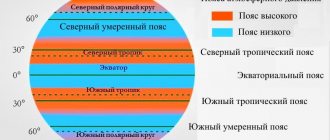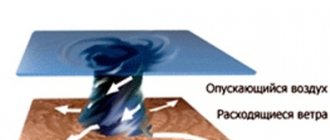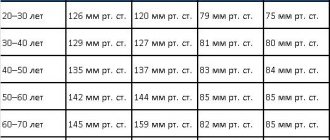Atmospheric pressure is the force with which a column of air presses on a certain unit area of the Earth. It is often measured in kilograms per square meter, and from there it is converted to other units. Atmospheric pressure varies across the globe depending on geographic location. Normal, habitual blood pressure is extremely important for the human body to function properly. You need to understand what atmospheric pressure is normal for a person, and how its changes can affect well-being.
When you rise to a height, the atmospheric pressure decreases, and when you go down, it increases. Also, this indicator may depend on the time of year and humidity in a particular area. In everyday life it is measured using a barometer. It is customary to indicate atmospheric pressure in millimeters of mercury.
The ideal atmospheric pressure is considered to be 760 mmHg, but in Russia and most of the planet in general, this figure is far from this ideal.
The normal force of air pressure is considered to be that at which a person feels comfortable. Moreover, for people from different habitats, the pressure indicators at which normal health remains will be different. A person usually gets used to the indicators of the area in which he lives. If a resident of the highlands moves to the lowlands, he will experience discomfort for some time and gradually get used to the new conditions.
However, even at a permanent place of residence, atmospheric pressure can change. This usually happens with changing seasons and sudden changes in weather. In this case, people with a number of pathologies and congenital weather dependence may experience discomfort, and old diseases may begin to worsen.
It is worth knowing how you can improve your condition if there is a sharp drop or increase in atmospheric pressure. You don’t have to immediately run to the doctor - there are home techniques that have been tested by many people that can help you start feeling better.
Important! It is worth noting that people sensitive to changing weather conditions should be more careful when choosing places to spend their holidays or move.
Definition and essence
The air in the atmosphere is a mixture of gases that have a certain density. Since the air mass is attracted to the globe, it presses on the entire surface of the planet. Including people.
Atmospheric pressure is the mass of air that presses on a person.
In numerical equivalent, the weight of the air mass that puts pressure on us every day varies between 14 and 16 tons or 1.033/cm³. So why don't we notice such heaviness? This is because the fluids in our body balance the pressure. If the force changes for some reason, the balance is upset.
What is it measured in?
Atmospheric pressure is measured using a barometer and thermohygrometer.
So the units of measurement for pressure are:
- millimeters of mercury (mmHg);
- Pascals;
- bars;
- kg/cm³;
- atmosphere.
What affects the indicator
Atmospheric pressure is a variable indicator; it changes depending on many factors:
- Location of the area above sea level.
- Time of day.
- Weather conditions.
- Climatic conditions.
- Relief.
When ascending one kilometer, the pressure drops by 0.13 from the previous value. For example, a kilometer from sea level, the atmospheric pressure is already 760 and 730 millimeters. This pattern is strictly observed at low altitudes. Then she gets confused.
When descending to a certain depth, the pressure changes in the same proportion.
At night, the pressure increases by 1-2 millimeters of mercury from the daytime value.
Due to the change of cyclones, in which low pressure prevails, and anticyclones, which carry increased atmospheric pressure, the indicator can fluctuate from 641 to 816 mm Hg. Art. at sea level.
Since the human body adapts to living conditions, people have different blood pressure standards. Thus, the norm of a Canadian resident will be significantly different from the norm of an Australian. And even within a country, the indicator may deviate.
Meteor dependence - what to do?
The movement of mercury by more than one division in 3 hours is a reason for stress in the strong body of a healthy person. Each of us feels such fluctuations in the form of headaches, drowsiness, and fatigue. More than a third of people suffer from weather dependence to varying degrees of severity. In the zone of high sensitivity are populations with diseases of the cardiovascular, nervous and respiratory systems, and elderly people. How to help yourself if a dangerous cyclone is approaching?
15 ways to survive a weather cyclone
There's not a lot of new advice here. It is believed that together they alleviate suffering and teach the correct way of life in case of weather vulnerability:
- See your doctor regularly. Consult, discuss, ask for advice in case your health worsens. Always have prescribed medications on hand.
- Buy a barometer. It is more productive to track the weather by the movement of the mercury column, rather than by knee pain. This way you will be able to anticipate the approaching cyclone.
- Keep an eye on the weather forecast. Forewarned is forearmed.
- On the eve of a weather change, get enough sleep and go to bed earlier than usual.
- Adjust your sleep schedule. Provide yourself with a full 8 hours of sleep, getting up and falling asleep at the same time. This has a powerful restorative effect.
- Meal schedule is equally important. Maintain a balanced diet. Potassium, magnesium and calcium are essential minerals. Ban on overeating.
- Take vitamins in a course in spring and autumn.
- Fresh air, walks outside - light and regular exercise strengthens the heart.
- Don't overexert yourself. Putting off household chores is not as dangerous as weakening the body before a cyclone.
- Accumulate favorable emotions. A depressed emotional background fuels the disease, so smile more often.
- Clothes made from synthetic threads and fur are harmful due to static current.
- Keep folk remedies for relieving symptoms in a list in a visible place. It’s hard to remember a recipe for herbal tea or a compress when your temples are aching.
- Office workers in high-rise buildings suffer more often from weather changes. Take time off if possible, or better yet, change jobs.
- A long cyclone means discomfort for several days. Is it possible to go to a quiet region? Forward.
- Prevention at least a day before the cyclone prepares and strengthens the body. Do not give up!
Atmospheric pressure standards
The ideal pressure is 760 millimeters of mercury or 1013.25 millibars. In such conditions a person does not feel any discomfort.
But this indicator is specifically measured above sea level in France at an air temperature of +15 degrees Celsius. It is very rarely found in other parts of the planet.
Since different countries have different topography, all inhabitants of the planet are adapted to their normal pressure. For example, residents of Mexico City do not tolerate the indicator considered normal, since their pressure does not exceed 580 mm Hg. Art.
What indicator is considered normal for a person?
Many experts say: normal blood pressure for a person will be 750–765 mmHg. It is easiest to adapt to indicators within these limits. For most people living on plains, small hills, and lowlands, they will be suitable.
It is worth noting that the most dangerous thing is not increased or decreased indicators, but their sudden change. If changes happen gradually, most people won't notice them. A sudden change can lead to negative consequences: some people may faint during a sharp climb uphill.
Pressure norm table
In different cities of the country, the indicators will be different - this is the norm. Usually detailed weather reports tell you whether the atmospheric pressure is above or below normal at a given time. You can always calculate the norm for your place of residence yourself, but it is easier to refer to ready-made tables. For example, here are the indicators for several cities in Russia:
It is worth noting that for some cities and regions large pressure drops are normal. Local residents are usually well adapted to them; only a visitor will feel unwell.
Important! If weather dependence occurs suddenly and has never been observed before, you should consult a doctor - this may indicate heart disease.
Fluctuations within normal limits
Changes of up to 5 mm are considered normal, and our body copes with them absolutely calmly. In this case, the person does not experience any discomfort or unpleasant sensations.
Fluctuations of 5 to 10 millimeters of mercury can cause discomfort for people with poor health.
More sudden changes can be fatal.
The influence of hell vibrations on the human body
Since balance is achieved through the fluids of our body - blood, lymph, tissue fluid - atmospheric pressure directly affects blood pressure. Changes in one lead to imbalance in the other.
Low barometer reading
A decrease in pressure, which is observed when rising to a height, can lead to the following consequences:
- labored breathing;
- low heart rate;
- fatigue, drowsiness;
- apathy;
- low blood pressure;
- headache;
- attacks of dizziness;
- nausea or vomiting;
- digestive system disorders;
- problems with concentration.
When air pressure decreases, people with respiratory pathologies and usually low blood pressure are at risk. Usually their condition gets worse under such conditions. If a person does not feel changes, such fluctuations can be considered normal for him.
High barometer reading
Fluctuations upward in the mercury column are observed when descending into mines, caves or other lowlands.
Discomfort will differ from low blood pressure:
- ringing in the ears, stuffy ears;
- pulsation in the temples and neck;
- increased blood pressure;
- increased heart rate;
- rush of blood to human skin, redness;
- spots before the eyes;
- headache:
- dizziness;
- nausea or vomiting.
With elevated atmospheric pressure, heart attacks and strokes often occur. People prone to weather dependence should monitor weather conditions and on days of high blood pressure not overload their body with stress or physical activity.
At-risk groups
If the mercury moves even one division in 2-3 hours, weather-dependent people will feel it. Fatigue, drowsiness, nausea and other unpleasant or even painful symptoms will immediately manifest themselves. Who are classified as people dependent on changes in atmospheric pressure?
How to feel better
It is very important to know how to eliminate the negative effects of the cyclone and anticyclone and improve your condition. This is especially true for weather-sensitive people, the elderly, patients with diagnosed pathologies of the respiratory, cardiovascular and central nervous systems.
In order to avoid adverse consequences and improve your well-being, you must take into account the following recommendations from specialists:
- Eat a balanced diet, avoiding the abuse of sweets, fatty, fried, spicy foods;
- Purchase a barometer that will allow you to monitor changes in atmospheric pressure and promptly take measures aimed at stabilizing your physical condition;
- Get proper rest and sleep;
- Follow a routine, trying to wake up and fall asleep at approximately the same time;
- Regularly study the weather forecast;
- Take walks in the fresh air;
- Give your body regular, feasible physical activity.
If you feel unwell due to changes in atmospheric pressure, it is recommended to consume less salt, do therapeutic exercises, drink green tea and herbal decoctions.
Consultation with a specialist will allow you to choose the best methods for improving your physical condition and eliminating unpleasant symptoms caused by the influence of atmospheric pressure!
How long has it been since you had a really BIG CATCH?
When was the last time you caught dozens of HUGE pike/carp/bream?
We always want to get results from fishing - to catch not three perch, but ten kilogram pikes - what a catch! Each of us dreams of this, but not everyone can do it.
A good catch can be achieved (and we know this) thanks to good bait.
It can be prepared at home or bought in fishing stores. But stores are expensive, and to prepare bait at home, you need to spend a lot of time, and, to be fair, homemade bait does not always work well.
You know that disappointment when you buy bait or prepare it at home and only catch three or four bass?
So maybe it’s time to use a truly working product, the effectiveness of which has been proven both scientifically and in practice on the rivers and ponds of Russia?
Of course, it is better to try once than to hear a thousand times. Moreover, now is the season! A 50% discount on your order is a great bonus!
September 14, Monday
at night
In Kanash, Russia, cloudy weather with light rain is expected. Chance of precipitation 98%. Atmospheric pressure is within normal limits (739–740 mm Hg). Air temperature +11. +14°C. The wind is weak (3–5 m/s). Relative humidity 55–96%.
Cloudy weather is expected in Kanash, Russia. Chance of precipitation 31%. Atmospheric pressure is within normal limits (739 mm Hg). Air temperature +11. +15°C. The wind is moderate (5–7 m/s). Relative humidity 52–85%.
September 15, Tuesday
at night
Cloudy weather is expected in Kanash, Russia. Chance of precipitation 9%. Atmospheric pressure is within normal limits (738–739 mm Hg). Air temperature +9. +10°C. Wind (3–5 m/s). Relative humidity 78–84%.
In Kanash, Russia, rain and thunderstorms are expected. Chance of precipitation 52%. Atmospheric pressure is within normal limits (738–739 mm Hg). Air temperature +9. +13°C. The wind is moderate (5–7 m/s). Relative humidity 66–80%.
September 16, Wednesday
at night
Cloudy weather is expected in Kanash, Russia. Chance of precipitation 10%. Atmospheric pressure is within normal limits (740–741 mm Hg). Air temperature +7. +8°C. Wind (5–6 m/s). Relative humidity 80–85%.
Cloudy weather is expected in Kanash, Russia. Chance of precipitation 19%. Atmospheric pressure is within normal limits (742–745 mm Hg). Air temperature +8. +11°C. The wind is moderate (4–6 m/s). Relative humidity 59–79%.
September 17, Thursday
at night
Cloudy weather is expected in Kanash, Russia. Chance of precipitation 0%. Atmospheric pressure is within normal limits (744–745 mm Hg). Air temperature +5. +6°C. The wind is weak (2–4 m/s). Relative humidity 86–94%.
Cloudy weather is expected in Kanash, Russia. Chance of precipitation 22%. Atmospheric pressure is within normal limits (730–743 mm Hg). Air temperature +10. +14°C. The wind is moderate (3–7 m/s). Relative humidity 54–70%.
September 18, Friday
at night
Cloudy weather is expected in Kanash, Russia. Chance of precipitation 23%. Atmospheric pressure is below normal (728–730 mm Hg). Air temperature +12. +13°C. Wind (5–6 m/s). Relative humidity 70–78%.
Find out more about the weather in Kanash, Russia
- Weather in Kanash, Russia (overview)
- Weather in Kanash, Russia now
- Weather in Kanash, Russia today hourly
- Weather in Kanash, Russia tomorrow hourly
- Weather in Kanash, Russia for 3 days
- Weather in Kanash, Russia for a week
- Weather in Kanash, Russia for 7 days hourly
- Weather in Kanash, Russia for 10 days
- Weather in Kanash, Russia for 14 days
- Weather archive in Kanash, Russia
Is it inconvenient to view the weather in Kanash, Russia in the form of tables, graphs, pictograms and indicators? Read the text weather forecast in Kanash, Russia for the week, which simply and clearly describes the development of weather in Kanash, Russia for the week, divided into day and night according to such parameters as the prevailing weather pattern, probability of precipitation, atmospheric pressure relative to normal, temperature range air, wind and relative humidity. Tired of reading? Switch to a detailed hourly weather forecast for Kanash, Russia or weather forecast in the form of visual graphs.
The Meteoservice.ru website presents weather in Moscow, St. Petersburg, Yekaterinburg, Kazan, Novosibirsk, Krasnodar, other cities of Russia, Belarus, Kazakhstan, other neighboring countries and large cities of the world based on its own technology, the so-called hybrid weather forecasting HFT (Hybrid Forecasting Technology). The weather in Moscow and St. Petersburg is presented with accuracy down to the regions; other large cities in Russia are next in line. Experience shows that forecasting the weather in Moscow with the accuracy of a street or house does not make much sense: with a significant increase in calculations, the accuracy of the forecasts increases by a fraction of a percent.
Normal atmospheric pressure for a person can vary depending on the place of residence, climatic conditions and other factors. Since atmospheric pressure affects the well-being of people, especially those suffering from weather dependence, it is important to know what its normal indicators are and how you can improve your condition.
Pressure standards depending on region
The standard standard atmospheric pressure for humans is 760 mm. Hg Art., at a temperature of +15°C. This indicator is typical for Paris, but is extremely rarely recorded in other parts of the world.
The level of atmospheric pressure depends on climate conditions and location. For example, in the mountains the pressure indicators will be completely different than on the plains.
There is a barometric formula according to which atmospheric pressure decreases by approximately 13% with an increase of one kilometer above sea level. In case of lowering, the indicator also decreases by 13%.
where P is the pressure at altitude h, P is the pressure at sea level (h=h), a is a coefficient depending on the temperature and properties of the gas (in this case, air).
The norm of atmospheric pressure is a conditional and relative concept. Ideally, it should be comfortable for a person and not affect his well-being, ability to work, or blood pressure.
Living for a long time in certain regions, the body adapts to local atmospheric pressure, climatic conditions, and weather.
Scientists have developed a special table that allows one to evaluate the normal atmospheric pressure indicators and the degree of its possible deviation for different regions.
| Place of residence | Average norm, mm Hg. Art. | Maximum permissible level of increase, mm Hg. Art. |
| Saint Petersburg | From 753 to 755 | 762 |
| Moscow | From 747 to 748 | 755 |
| Tyumen | From 770 to 771 | 775 |
| Yaroslavl | From 720 to 752 | 758 |
| Vladivostok | From 750 to 761 | 765 |
| Samara | From 752 to 753 | 760 |
| Izhevsk | From 746 to 747 | 753 |
| Chelyabinsk | From 737 to 744 | 756 |
| Tula | From 746 to 747 | 755 |
| Permian | From 744 to 745 | 751 |
| Rostov-on-Don | From 740 to 741 | 748 |
| Ekaterinburg | From 735 to 741 | 755 |
Atmospheric pressure and human well-being are interconnected. Therefore, when moving to another area, people may experience discomfort and malaise until the body adapts to the new conditions.
How does atmospheric pressure affect humans?
According to medical experts, the effect of atmospheric pressure on the human body is determined exclusively on an individual basis. An indicator of the norm can be considered a comfortable, satisfactory state of health, the absence of any painful symptoms. However, there are certain criteria to which the body reacts negatively:
- A decrease or increase in the level of atmospheric pressure from 5 to 10 units, especially with an accompanying change in weather conditions. For local residents, accustomed to sub-brow fluctuations, the differences will be much less noticeable than for visitors.
- Changes in atmospheric pressure of 1-2 units do not have a negative effect on the human body and are considered normal.
- In mountainous areas, pressure readings can drop very much - up to 30 mm Hg. Art., which has an extremely negative effect on people who are not accustomed to such conditions, provoking fainting and a significant deterioration in general well-being.
Comfortable atmospheric pressure, according to experts, is optimal and unnoticeable for humans. Particularly dangerous are sharp fluctuations upward or downward, which are a stress factor even for healthy people. Persons prone to weather dependence may exhibit painful symptoms such as headaches, tachycardia, weakness, malaise, increased drowsiness and decreased ability to work.
Who is at risk
Changes in atmospheric pressure have the greatest impact on people suffering from various diseases and serious health problems. This is due to the fact that when the barometer fluctuates, pressure levels in the body also change, leading to irritation of specific baroreceptors.
According to doctors, high-risk groups include:
- Patients suffering from hypertension;
- Asthmatics:
- Persons who have suffered traumatic brain injuries;
- Patients with diagnosed hypotension;
- Persons with elevated intracranial pressure;
- Patients suffering from diseases of the musculoskeletal system (arthritis, arthrosis, osteochondrosis, radiculitis);
- Patients with atherosclerosis;
- Patients suffering from chronic pleurisy, bronchitis;
- Persons with traumatic chest injuries;
- Patients with otolaryngological pathologies (otitis, rhinitis, sinusitis, frontal sinusitis).
People who are most at risk are weather-sensitive people who react sharply to changes in weather, climatic conditions, and changes in atmospheric pressure.
Low atmospheric pressure (cyclone)
A cyclone is a low level of atmospheric pressure, accompanied by high levels of air humidity, precipitation, and unstable temperature conditions. Low atmospheric pressure has a negative effect on the human body, causing the following symptoms:
- Slow heart rate (bradycardia);
- Flatulence;
- Reduced blood pressure;
- Migraine attacks;
- Dyspnea;
- Respiratory dysfunction;
- Increased level of intracranial pressure.
The cyclone has the greatest impact on people with diagnosed hypotension, gastrointestinal pathologies, and cardiac diseases.
High atmospheric pressure (Anticyclone)
An increase in atmospheric pressure is called an anticyclone. Accompanied by a stable temperature regime, dry, sunny weather, without precipitation. High atmospheric pressure also does not have the best effect on the condition of the human body, causing the following clinical signs:
- Cardiopalmus;
- Severe dizziness;
- Headache;
- Increased blood pressure;
- Pulsating, painful sensations localized in the temporal region;
- Hyperemia of the skin;
- Weakness, increased fatigue;
- Pain in the heart area;
- Cough syndrome;
- lacrimation;
- Runny nose.
The anticyclone has a particularly strong effect on the well-being of people who have a tendency to exhibit allergic reactions, suffer from bronchial asthma, and arterial hypertension.
Blood pressure: what is considered normal, how to measure it, what to do if it is high and low?
Humanity owes a lot to the Italian Riva-Rocci, who at the end of the last century invented a device that measures blood pressure (BP). At the beginning of the last century, this invention was wonderfully supplemented by the Russian scientist N.S. Korotkov, proposing a method for measuring pressure in the brachial artery with a phonendoscope. Although the Riva-Rocci apparatus was bulky compared to current tonometers and was indeed mercury-based, the principle of its operation did not change for almost 100 years. And the doctors loved him. Unfortunately, now you can only see it in a museum, because it has been replaced by compact (mechanical and electronic) devices of a new generation. But the auscultatory method of N.S. Korotkova is still with us and is successfully used by both doctors and their patients.
Where is the norm?
The normal blood pressure in adults is considered to be 120/80 mmHg. Art. But can this indicator be fixed if a living organism, which is a person, must constantly adapt to different conditions of existence? And people are all different, so blood pressure still deviates within reasonable limits.
Even though modern medicine has abandoned the previous complex formulas for calculating blood pressure, which took into account such parameters as gender, age, weight, there are still discounts on something. For example, for an asthenic “lightweight” woman, the pressure is 110/70 mm Hg. Art. is considered quite normal, and if blood pressure increases by 20 mm Hg. Art., then she will certainly feel it. In the same way, the normal pressure will be 130/80 mmHg. Art. for a trained young man. After all, athletes usually have it this way.
Fluctuations in blood pressure will still be influenced by factors such as age, physical activity, psycho-emotional situation, climatic and weather conditions. Arterial hypertension (AH), perhaps, would not have befallen a hypertensive patient if he lived in another country. Otherwise, how can we understand the fact that on the black African continent, hypertension can be found only occasionally among the indigenous population, while blacks in the USA suffer from it en masse? It turns out that blood pressure does not depend on race alone.
However, if the pressure rises slightly (10 mm Hg) and only to give a person the opportunity to adapt to the environment, that is, occasionally, all this is considered normal and does not give reason to think about the disease.
With age, blood pressure also rises slightly. This is due to changes in the blood vessels, which deposit something on their walls. In practically healthy people, the deposits are very small, so the pressure will increase by 10-15 mm Hg. pillar
If blood pressure values exceed 140/90 mm Hg. Art., will steadfastly stay at this figure, and sometimes even move upward, such a person will be diagnosed with arterial hypertension of the appropriate degree, depending on the pressure values. Consequently, for adults there is no norm for blood pressure by age; there is only a small discount for age. But for children everything is a little different.
Video: how to keep blood pressure normal?
What about the children?
Blood pressure in children has different values than in adults. And it grows, starting from birth, at first quite quickly, then growth slows down, with some upward leaps in adolescence, and reaches the level of blood pressure of an adult. Of course, it would be surprising if the pressure of such a small newborn baby, with everything so “new”, was 120/80 mmHg. Art.
The structure of all organs of a newly born baby is not yet complete, this also applies to the cardiovascular system. The blood vessels of a newborn are elastic, their lumen is wider, the network of capillaries is larger, so the pressure is 60/40 mm Hg. Art. for him it will be the absolute norm. Although, perhaps, someone will be surprised by the fact that yellow lipid stains can be found in the aorta of newborns, which, however, do not affect health and go away over time. But this is so, a retreat.
As the baby develops and his body further develops, blood pressure rises and by the age of one year the normal figures will be 90-100/40-60 mmHg. Art., and the child will reach the values of an adult only by the age of 9-10. However, at this age the pressure is 100/60 mmHg. Art. will be considered normal and will not surprise anyone. But in adolescents, a blood pressure value that is considered normal is slightly higher than that established for adults, 120/80. This is probably due to the hormonal surge characteristic of adolescence. To calculate normal blood pressure values in children, pediatricians use a special table, which we bring to the attention of readers.
Age
Normal minimum systolic pressure
Normal maximum systolic pressure
Normal minimum diastolic pressure
Normal maximum diastolic pressure
| Up to 2 weeks | 60 | 96 | 40 | 50 |
| 2-4 weeks | 80 | 112 | 40 | 74 |
| 2-12 months | 90 | 112 | 50 | 74 |
| 2-3 years | 100 | 112 | 60 | 74 |
| 3-5 years | 100 | 116 | 60 | 76 |
| 6-9 years | 100 | 122 | 60 | 78 |
| 10-12 years | 110 | 126 | 70 | 82 |
| 13-15 years old | 110 | 136 | 70 | 86 |
Blood pressure problems in children and adolescents
Unfortunately, such a pathology as arterial hypertension is no exception for the child’s body. Lability of blood pressure most often manifests itself in adolescence, when the body is undergoing restructuring, but the puberty period is dangerous because a person at this time is not yet an adult, but no longer a child. This age is difficult for the person himself, because pressure surges are often caused by the instability of the teenager’s nervous system, both for his parents and for the attending physician. However, pathological deviations must be noticed and leveled out in time. This is the task of adults.
The causes of increased blood pressure in children and adolescents may be:
- Alimentary-constitutional obesity;
- Children's fears and experiences, which the child, as a rule, is in no hurry to share with his parents;
- Low physical activity, which is typical for many modern children, due to the craze for computer games (jump ropes and “hopscotch” have long been forgotten, outdoor games are only in physical education class, and even then without enthusiasm);
- Insufficient exposure to fresh air (oxygen starvation of tissues);
- Predilection for salty foods, which includes chips beloved by children;
- Kidney diseases;
- Endocrine disorders.
As a result of the influence of these factors, vascular tone increases, the heart begins to work harder, especially its left part. If urgent measures are not taken, a young person may meet his adulthood with a ready-made diagnosis: arterial hypertension or, at best, neurocirculatory dystonia of one type or another.
Measuring blood pressure at home
We talk about blood pressure for quite a long time, implying that all people know how to measure it. It seems that there is nothing complicated, we put a cuff above the elbow, pump air into it, slowly release it and listen.
Everything is correct, but before moving on to blood pressure in adults, I would like to dwell on the algorithm for measuring blood pressure, since patients often do this on their own and not always according to the method. As a result, inadequate results are obtained, and, accordingly, unreasonable use of antihypertensive drugs. In addition, when people talk about upper and lower blood pressure, they do not always understand what it all means.
To correctly measure blood pressure, it is very important what conditions a person is in. To avoid getting “random numbers”, in America they measure blood pressure following the following rules:
- A comfortable environment for a person whose blood pressure is of interest should be at least 5 minutes;
- Half an hour before the procedure, do not smoke or eat;
- Visit the toilet so that your bladder is not full;
- Take into account tension, pain, feeling unwell, taking medications;
- Measure blood pressure twice on both arms in a lying, sitting, standing position.
Probably, each of us will not agree with this, unless such a measurement is suitable for a military registration and enlistment office or in strict stationary conditions. Nevertheless, you should strive to fulfill at least some points. For example, it would be good to measure blood pressure in a calm environment, with the person comfortably laid out or seated, and to take into account the influence of a “good” smoke break or a hearty lunch just eaten. It should be remembered that the antihypertensive drug taken might not yet have had its effect (not much time has passed) and you might not grab the next pill after seeing a disappointing result.
A person, especially if he is not completely healthy, usually does a poor job of measuring his own blood pressure (it costs a lot to put a cuff on!). It is better if one of the relatives or neighbors does this. You also need to take the method of measuring blood pressure very seriously.
Video: measuring pressure with an electronic tonometer
Cuff, tonometer, phonendoscope... systole and diastole
The algorithm for determining blood pressure (auscultatory method by N.S. Korotkov, 1905) is very simple if everything is done correctly. The patient is seated comfortably (you can lie down) and measurement begins:
- Air is released from the cuff connected to the tonometer and the bulb by squeezing it with the palms;
- Wrap the cuff around the patient’s arm above the elbow (tightly and evenly), trying to ensure that the rubber connecting tube is on the side of the artery, otherwise you may get an incorrect result;
- Select a listening location and install a phonendoscope;
- Inflate air into the cuff;
- When inflating air, the cuff compresses the arteries due to its own pressure, which is 20-30 mm Hg. Art. above the pressure at which the sounds heard on the brachial artery with each pulse wave completely disappear;
- Slowly releasing air from the cuff, listen to the sounds of the artery on the elbow;
- The first sound heard by the phonendoscope is recorded with a glance on the tonometer scale. It will mean the breakthrough of a portion of blood through the compressed area, since the pressure in the artery has slightly exceeded the pressure in the cuff. The impact of escaping blood against the wall of the artery is called Korotkoff sound, upper or systolic pressure;
- The series of sounds, noises, tones following systole is understandable to cardiologists, but ordinary people must catch the last sound, which is called diastolic or lower, it is also noted visually.
Thus, contracting, the heart pushes blood into the arteries (systole), creating pressure on them equal to the upper or systolic. Blood begins to distribute through the vessels, which leads to a decrease in pressure and relaxation of the heart (diastole). This is the last, lower, diastolic beat.
However, there are nuances...
Scientists have found that when measuring blood pressure using the traditional method, its values are 10% different from the true ones (direct measurement in the artery during its puncture). Such an error is more than compensated for by the accessibility and simplicity of the procedure; moreover, as a rule, one measurement of blood pressure in the same patient is not enough, and this makes it possible to reduce the magnitude of the error.
In addition, the patients do not differ in the same build. For example, thin people have lower detectable values. But for overweight people, on the contrary, it is higher than in reality. This difference can be leveled out by a cuff with a width of more than 130 mm. However, there are not just fat people. Obesity of 3-4 degrees often makes it difficult to measure blood pressure on the arm. In such cases, the measurement is carried out on the leg using a special cuff.
There are cases when, with the auscultatory method of measuring blood pressure in the interval between the upper and lower arterial pressure, a break is observed in the sound wave (10-20 mm Hg or more), when there are no sounds above the artery (complete silence), but on the vessel itself there is a pulse. This phenomenon is called an auscultatory “dip,” which can occur in the upper or middle third of the pressure amplitude. Such a “failure” should not go unnoticed, because then a lower blood pressure value (the lower limit of the auscultatory “failure”) will be mistakenly taken for the value of systolic pressure. Sometimes this difference can be even 50 mm Hg. Art., which, naturally, will greatly affect the interpretation of the result and, accordingly, treatment, if necessary.
An error like this is highly undesirable and can be avoided. To do this, simultaneously with pumping air into the cuff, the pulse in the radial artery should be monitored. The pressure in the cuff must be increased to values sufficiently above the level at which the pulse disappears.
The phenomenon of “endless tone” is well known to adolescents, sports doctors and in military registration and enlistment offices when examining conscripts. The nature of this phenomenon is considered to be a hyperkinetic type of blood circulation and low vascular tone, the cause of which is emotional or physical stress. In this case, it is not possible to determine the diastolic pressure; it seems that it is simply zero. However, after a few days, in a relaxed state of the young man, measuring the lower pressure does not present any difficulties.
Video: measuring pressure using the traditional method
Blood pressure increases... (hypertension)
The causes of high blood pressure in adults are not much different from those in children, but those who are... undoubtedly have more risk factors:
- Of course, atherosclerosis, leading to vasoconstriction and increased blood pressure;
- BP clearly correlates with excess weight;
- Glucose levels (diabetes mellitus) greatly influence the formation of arterial hypertension;
- Excessive consumption of table salt;
- Life in the city, because it is known that an increase in blood pressure parallels the acceleration of the pace of life;
- Alcohol. Strong tea and coffee become a cause only when they are consumed in excessive quantities;
- Oral contraceptives, which many women use to avoid unwanted pregnancy;
- Smoking itself, perhaps, would not be among the causes of high blood pressure, but this bad habit has too bad an effect on the blood vessels, especially peripheral ones;
- Low physical activity;
- Professional activities associated with high psycho-emotional stress;
- Changes in atmospheric pressure, changes in weather conditions;
- Many other diseases, including surgical ones.
People suffering from arterial hypertension, as a rule, control their condition themselves by constantly taking medications to lower blood pressure, prescribed by a doctor in individually selected dosages. These may be beta blockers, calcium antagonists or ACE inhibitors. Considering the good awareness of patients about their illness, there is no point in dwelling too much on arterial hypertension, its manifestations and treatment.
However, everything begins somewhere, and so it is with hypertension. It is necessary to determine whether this is a one-time increase in blood pressure caused by objective reasons (stress, drinking alcohol in inadequate doses, certain medications), or whether there is a tendency to increase it on an ongoing basis, for example, blood pressure rises in the evening, after a working day.
It is clear that an evening rise in blood pressure indicates that during the day a person bears an excessive load on himself, so he must analyze the day, find the cause and begin treatment (or prevention). In such cases, the presence of hypertension in the family should be even more alarming, since it is known that this disease has a hereditary predisposition.
If high blood pressure is recorded repeatedly, even in numbers of 135/90 mm Hg. Art., then it is advisable to start taking measures to prevent it from becoming high. It is not necessary to immediately resort to medications; you can first try to regulate your blood pressure by following a regimen of work, rest and nutrition.
Of course, diet plays a special role in this regard. By giving preference to products that lower blood pressure, you can do without pharmaceuticals for a long time, or even avoid taking them altogether, if you do not forget about folk recipes containing medicinal herbs.
By creating a menu of such affordable foods as garlic, cabbage and Brussels sprouts, beans and peas, milk, baked potatoes, salmon fish, spinach, you can eat well and not feel hungry. And bananas, kiwi, orange, pomegranate can perfectly replace any dessert and at the same time normalize blood pressure.
Video: hypertension in the program “Live Healthy!”
Blood pressure is low... (hypotension)
Low blood pressure, although not fraught with such dangerous complications as high blood pressure, is still uncomfortable for a person to live with. Typically, such patients have a diagnosis of vegetative-vascular (neurocirculatory) dystonia of the hypotonic type, which is quite common these days, when at the slightest sign of unfavorable conditions, blood pressure decreases, which is accompanied by pallor of the skin, dizziness, nausea, general weakness and malaise. Patients break into a cold sweat and may faint.
There are many reasons for this, the treatment of such people is very difficult and lengthy, moreover, there are no medications for constant use, except that patients often drink freshly brewed green tea, coffee and occasionally take tincture of Eleutherococcus, ginseng and pantocrine tablets. Regime, especially sleep, which requires at least 10 hours, helps normalize blood pressure in such patients. Nutrition for hypotension should be sufficiently high in calories, because low blood pressure requires glucose. Green tea has a beneficial effect on blood vessels during hypotension, increasing blood pressure somewhat and thereby bringing a person to his senses, which is especially noticeable in the morning. A cup of coffee also helps, but you should remember that the drink is addictive, that is, you can get hooked on it unnoticed.
The range of health measures for low blood pressure includes:
- Healthy lifestyle (active recreation, sufficient time in the fresh air);
- High physical activity, sports;
- Water treatments (aroma baths, hydromassage, swimming pool);
- Spa treatment;
- Diet;
- Elimination of provoking factors.
Help yourself!
If you have problems with blood pressure, you should not passively wait for the doctor to come and cure everything. The success of prevention and treatment largely depends on the patient himself. Of course, if you suddenly end up in a hospital with a hypertensive crisis, then they will prescribe a blood pressure profile and select pills. But when a patient comes to an outpatient appointment with complaints of increased blood pressure, he will have to take on a lot. For example, according to words, it is difficult to track the dynamics of blood pressure, so the patient is asked to keep a diary (at the observation stage for the selection of antihypertensive drugs - a week, during long-term use of drugs - 2 weeks 4 times a year, that is, every 3 months).
The diary can be an ordinary school notebook, divided into columns for convenience. It should be remembered that the measurement of the first day, although carried out, is not taken into account. In the morning (6-8 hours, but always before taking medications) and in the evening (18-21 hours) you need to take 2 measurements. Of course, it will be better if the patient is so careful that he measures the pressure every 12 hours at the same time.
And it would be good to remember the recommendations for measuring pressure written at the beginning of the article:
- Rest for 5 minutes, and if there was emotional or physical stress, then 15-20 minutes;
- An hour before the procedure, do not drink strong tea and coffee, do not think about alcoholic beverages, do not smoke for half an hour (tolerate it!);
- Do not comment on the actions of the person measuring, do not discuss the news, remember that there should be silence when measuring blood pressure;
- Sit comfortably, keeping your hand on a hard surface.
- Carefully record your blood pressure values in a notebook so that you can later show your notes to your doctor.
You can talk about blood pressure for a long time and a lot, patients love to do this, sitting under the doctor’s office, but you can talk, but you should not take advice and recommendations into account, because everyone has their own cause of arterial hypertension, their own concomitant diseases and their own medicine. For some patients, blood pressure-lowering medications take more than one day to select, so it is better to trust one person - the doctor.
Source: hyperton.ru










